

Compact Muon Solenoid
LHC, CERN
| CMS-HIN-19-008 ; CERN-EP-2020-155 | ||
| Search for strong electric fields in PbPb collisions at ${\sqrt {\smash [b]{s_{_{\mathrm {NN}}}}}} = $ 5.02 TeV using azimuthal anisotropy of prompt ${\mathrm{D^0}}$ and ${\mathrm{\overline{D}}{}^0}$ mesons | ||
| CMS Collaboration | ||
| 26 September 2020 | ||
| Phys. Lett. B 816 (2021) 136253 | ||
| Abstract: The strong Coulomb field created in ultrarelativistic heavy ion collisions is expected to produce a rapidity-dependent difference ($\Delta v_{2}$) in the second Fourier coefficient of the azimuthal distribution (elliptic flow, $v_{2}$) between ${\mathrm{D^0}}$ ($\mathrm{\bar{u}}\mathrm{c}$) and ${\mathrm{\overline{D}}{}^0}$ ($\mathrm{u}\mathrm{\bar{c}}$) mesons. Motivated by the search for evidence of this field, the CMS detector at the LHC is used to perform the first measurement of $\Delta v_{2}$. The rapidity-averaged value is found to be $<\Delta v_{2} > = $ 0.001 $\pm$ 0.001 (stat) $\pm$ 0.003 (syst) in PbPb collisions at ${\sqrt {\smash [b]{s_{_{\mathrm {NN}}}}}} = $ 5.02 TeV. In addition, the influence of the collision geometry is explored by measuring the ${\mathrm{D^0}}$ and ${\mathrm{\overline{D}}{}^0}$ mesons $v_{2}$ and triangular flow coefficient ($v_{3}$) as functions of rapidity, transverse momentum (${p_{\mathrm{T}}}$), and event centrality (a measure of the overlap of the two Pb nuclei). A clear centrality dependence of prompt ${\mathrm{D^0}}$ meson $v_{2}$ values is observed, while the $v_{3}$ is largely independent of centrality. These trends are consistent with expectations of flow driven by the initial-state geometry. | ||
| Links: e-print arXiv:2009.12628 [hep-ex] (PDF) ; CDS record ; inSPIRE record ; HepData record ; CADI line (restricted) ; | ||
| Figures | |
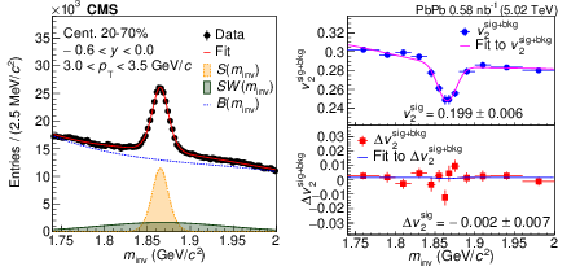
png pdf |
Figure 1:
Simultaneous fit of the $\pi \mathrm{K} $ invariant mass (left) and $ {v_{2}} $ ($\Delta {v_{2}} $) as function of invariant mass (right) for 3.0 $ < {p_{\mathrm {T}}} < $ 3.5 GeV/$c$, centrality 20-70%, and $-0.6 < y < 0.0$. |

png pdf |
Figure 1-a:
$\pi \mathrm{K} $ invariant mass $ {v_{2}} $ for 3.0 $ < {p_{\mathrm {T}}} < $ 3.5 GeV/$c$, centrality 20-70%, and $-0.6 < y < 0.0$, with superimposed result of the simultaneous fit. |
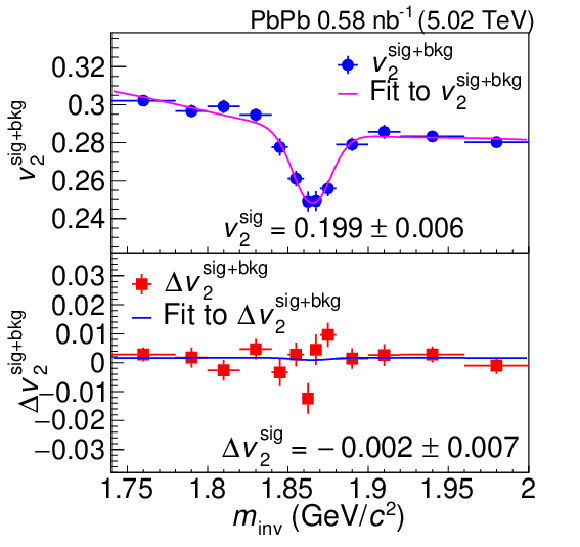
png pdf |
Figure 1-b:
$ {v_{2}} $ ($\Delta {v_{2}} $) as function of invariant mass (right) for 3.0 $ < {p_{\mathrm {T}}} < $ 3.5 GeV/$c$, centrality 20-70%, and $-0.6 < y < 0.0$, with superimposed result of the simultaneous fit. |
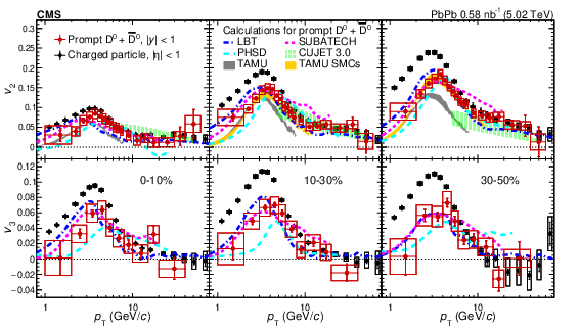
png pdf |
Figure 2:
Prompt ${\mathrm{D^0}}$ meson flow coefficients $ {v_{2}} $ (upper) and $ {v_{3}} $ (lower) at midrapidity ($ {| y |} < $ 1.0) for the centrality classes 0-10% (left), 10-30% (middle), and 30-50% (right). The vertical bars and open boxes represent the statistical and systematic uncertainties, respectively. The horizontal bars represent the width of each ${p_{\mathrm {T}}}$ bin. Theoretical calculations for $ {v_{\mathrm {n}}} $ coefficients of prompt ${\mathrm{D^0}}$ mesons are also plotted for comparison (LBT [32], CUJET 3.0 [33], SUBATECH [34], TAMU [35], and PHSD [15]). |

png pdf |
Figure 3:
Prompt ${\mathrm{D^0}}$ meson flow coefficients $ {v_{2}} $ (upper) and $ {v_{3}} $ (lower) at midrapidity ($ {| y |} < $ 1, red open circles) and forward rapidity (1 $ < {| y |} < $ 2, blue open diamonds) for the centrality classes 0-10% (left), 10-30% (middle), and 30-50% (right). The vertical bars and open boxes represent the statistical and systematic uncertainties, respectively. The horizontal bars represent the width of each ${p_{\mathrm {T}}}$ bin. |

png pdf |
Figure 4:
Prompt ${\mathrm{D^0}}$ meson $ {v_{2}} $ and $ {v_{3}} $ as functions of centrality, for 2.0 $ < {p_{\mathrm {T}}} < $ 8.0 GeV/$c$ and for rapidity ranges $ {| y |} < $ 1 and 1 $ < {| y |} < $ 2 (left). Prompt ${\mathrm{D^0}}$ $ {v_{2}} $ and $ {v_{3}} $ as functions of rapidity, for 2.0 $ < {p_{\mathrm {T}}} < $ 8.0 GeV/$c$ and for centrality 20-70% (right). The vertical bars represent statistical uncertainties and open boxes represent systematic uncertainties. The horizontal bars represent the width of each bin. |
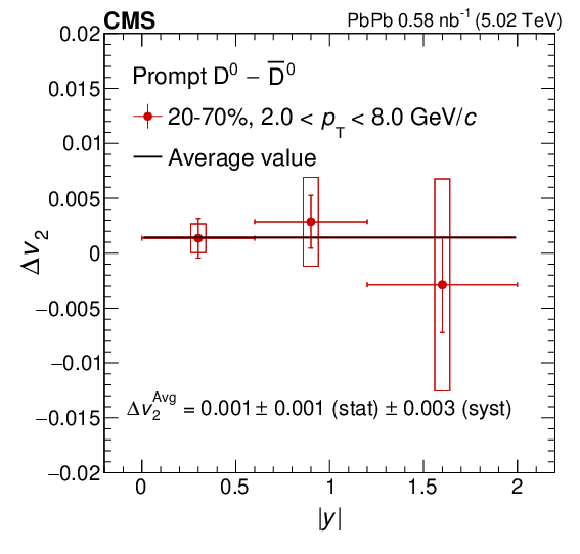
png pdf |
Figure 5:
Prompt ${\mathrm{D^0}}$ meson $\Delta {v_{2}} $ as a function of rapidity, for 2.0 $ < {p_{\mathrm {T}}} < $ 8.0 GeV/$c$ and centrality 20-70%. The vertical bars represent statistical uncertainties and open boxes represent systematic uncertainties. The horizontal bars represent the width of each bin. |
| Tables | |
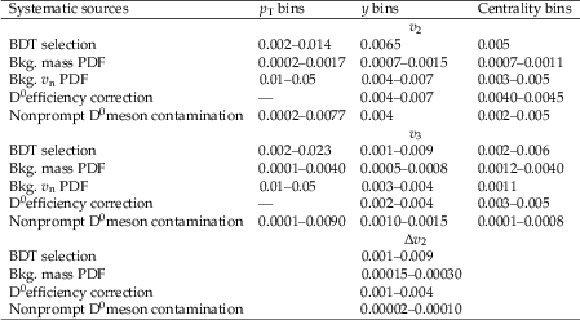
png pdf |
Table 1:
Summary of systematic uncertainties in absolute values for $ {v_{2}} $, $ {v_{3}} $, and $\Delta {v_{2}} $. Ranges of the variation of uncertainties for all the bins are presented. The cells filled with "---'' refer to the cases where the uncertainty cancels out. |
| Summary |
|
Measurements of the elliptic ($v_{2}$) and triangular ($v_{3}$) flow coefficients of prompt ${\mathrm{D^0}}$ mesons are presented as functions of transverse momentum (${p_{\mathrm{T}}}$), rapidity, and collision centrality, in PbPb collisions at ${\sqrt {\smash [b]{s_{_{\mathrm {NN}}}}}} = $ 5.02 TeV. The results improve previously published CMS data by extending the ${p_{\mathrm{T}}}$ and rapidity coverage and by providing more differential information in ${p_{\mathrm{T}}}$, rapidity, and centrality. A clear centrality dependence of prompt ${\mathrm{D^0}}$ meson $v_{2}$ is observed, while $v_{3}$ is largely centrality independent. These trends are consistent with the expectation that $v_{2}$ and $v_{3}$ are driven by initial-state geometry. A weak rapidity dependence of prompt ${\mathrm{D^0}}$ meson $v_{2}$ and $v_{3}$ is observed. When comparing various theoretical calculations to the data at midrapidity, no model is able to describe the data over the full centrality and ${p_{\mathrm{T}}}$ ranges. Motivated by the search for evidence of the strong electric field expected in PbPb collisions, a first measurement of the $v_{2}$ flow coefficient difference ($\Delta v_{2}$) between ${\mathrm{D^0}}$ and ${\mathrm{\overline{D}}{}^0}$ mesons as a function of rapidity is presented. The rapidity-averaged $v_{2}$ difference is measured to be $<\Delta v_{2} > = $ 0.001 $\pm$ 0.001 (stat) $\pm$ 0.003 (syst). This indicates that there is no evidence that charm hadron collective flow is affected by the strong Coulomb field created in ultrarelativistic heavy ion collisions. Future comparisons of theoretical models with these results may provide constraints on the electric conductivity of the quark-gluon plasma. |
| References | ||||
| 1 | BRAHMS Collaboration | Quark-gluon plasma and color glass condensate at RHIC? the perspective from the BRAHMS experiment | NP A 757 (2005) 1 | nucl-ex/0410020 |
| 2 | PHOBOS Collaboration | The PHOBOS perspective on discoveries at RHIC | NP A 757 (2005) 28 | nucl-ex/0410022 |
| 3 | STAR Collaboration | Experimental and theoretical challenges in the search for the quark gluon plasma: The STAR Collaboration's critical assessment of the evidence from RHIC collisions | NP A 757 (2005) 102 | nucl-ex/0501009 |
| 4 | PHENIX Collaboration | Formation of dense partonic matter in relativistic nucleus-nucleus collisions at RHIC: Experimental evaluation by the PHENIX collaboration | NP A 757 (2005) 184 | nucl-ex/0410003 |
| 5 | B. Muller, J. Schukraft, and B. Wyslouch | First results from PbPb collisions at the LHC | Ann. Rev. Nucl. Part. Sci. 62 (2012) 361 | 1202.3233 |
| 6 | N. Armesto and E. Scomparin | Heavy-ion collisions at the Large Hadron Collider: a review of the results from Run 1 | EPJPlus 131 (2016) 52 | 1511.02151 |
| 7 | ALICE Collaboration | Elliptic flow of charged particles in PbPb collisions at 2.76 TeV | PRL 105 (2010) 252302 | 1011.3914 |
| 8 | ATLAS Collaboration | Measurement of the pseudorapidity and transverse momentum dependence of the elliptic flow of charged particles in lead-lead collisions at $ {\sqrt {\smash [b]{s_{_{\mathrm {NN}}}}}} = $ 2.76 TeV with the ATLAS detector | PLB 707 (2012) 330 | 1108.6018 |
| 9 | CMS Collaboration | Measurement of the elliptic anisotropy of charged particles produced in PbPb collisions at $ {\sqrt {\smash [b]{s_{_{\mathrm {NN}}}}}} = $ 2.76 TeV | PRC 87 (2013) 014902 | CMS-HIN-10-002 1204.1409 |
| 10 | J.-Y. Ollitrault | Determination of the reaction plane in ultrarelativistic nuclear collisions | PRD 48 (1993) 1132 | nucl-ex/9303247 |
| 11 | S. Voloshin and Y. Zhang | Flow study in relativistic nuclear collisions by Fourier expansion of azimuthal particle distributions | Z. Phys. C 70 (1994) 665 | nucl-ex/9407282 |
| 12 | A. M. Poskanzer and S. A. Voloshin | Methods for analyzing anisotropic flow in relativistic nuclear collisions | PRC 58 (1998) 1671 | nucl-ex/9805001 |
| 13 | D. Molnar and S. A. Voloshin | Elliptic flow at large transverse momenta from quark coalescence | PRL 91 (2003) 092301 | nucl-th/0302014 |
| 14 | P. Braun-Munzinger | Quarkonium production in ultra-relativistic nuclear collisions: Suppression versus enhancement | JPG 34 (2007) 471 | nucl-th/0701093 |
| 15 | F.-M. Liu and S.-X. Liu | Quark-gluon plasma formation time and direct photons from heavy ion collisions | PRC 89 (2014) 034906 | 1212.6587 |
| 16 | U. Gursoy et al. | Charge-dependent flow induced by magnetic and electric fields in heavy ion collisions | PRC 98 (2018) 055201 | 1806.05288 |
| 17 | S. K. Das et al. | Directed flow of charm quarks as a witness of the initial strong magnetic field in ultra-relativistic heavy ion collisions | PLB 768 (2017) 260 | 1608.02231 |
| 18 | S. Chatterjee and P. Bozek | Large directed flow of open charm mesons probes the three dimensional distribution of matter in heavy ion collisions | PRL 120 (2018) 192301 | 1712.01189 |
| 19 | STAR Collaboration | Elliptic flow from two and four particle correlations in AuAu collisions at $ {\sqrt {\smash [b]{s_{_{\mathrm {NN}}}}}} = $ 130 GeV | PRC 66 (2002) 034904 | nucl-ex/0206001 |
| 20 | M. Luzum and J.-Y. Ollitrault | Eliminating experimental bias in anisotropic-flow measurements of high-energy nuclear collisions | PRC 87 (2013) 044907 | 1209.2323 |
| 21 | H. Voss, A. Hocker, J. Stelzer, and F. Tegenfeldt | TMVA, the toolkit for multivariate data analysis with ROOT | in XIth International Workshop on Advanced Computing and Analysis Techniques in Physics Research (ACAT), p. 40 2007 [PoS(ACAT)040] | physics/0703039 |
| 22 | CMS Collaboration | Measurement of prompt $ {\mathrm{D^0}} $ meson azimuthal anisotropy in PbPb collisions at $ {\sqrt {\smash [b]{s_{_{\mathrm {NN}}}}}} = $ 5.02 TeV | PRL 120 (2018) 202301 | CMS-HIN-16-007 1708.03497 |
| 23 | CMS Collaboration | The CMS experiment at the CERN LHC | JINST 3 (2008) S08004 | CMS-00-001 |
| 24 | CMS Collaboration | The CMS trigger system | JINST 12 (2017) P01020 | CMS-TRG-12-001 1609.02366 |
| 25 | CMS Collaboration | Charged-particle nuclear modification factors in PbPb and pPb collisions at $ {\sqrt {\smash [b]{s_{_{\mathrm {NN}}}}}} = $ 5.02 TeV | JHEP 04 (2017) 039 | CMS-HIN-15-015 1611.01664 |
| 26 | T. Sjostrand et al. | An introduction to PYTHIA 8.2 | CPC 191 (2015) 159 | 1410.3012 |
| 27 | CMS Collaboration | Extraction and validation of a new set of CMS PYTHIA 8 tunes from underlying-event measurements | EPJC 80 (2020) 4 | CMS-GEN-17-001 1903.12179 |
| 28 | I. P. Lokhtin and A. M. Snigirev | A model of jet quenching in ultrarelativistic heavy ion collisions and high-$ {p_{\mathrm{T}}} $ hadron spectra at RHIC | EPJC 45 (2006) 211 | hep-ph/0506189 |
| 29 | Particle Data Group, M. Tanabashi et al. | Review of particle physics | PRD 98 (2018) 030001 | |
| 30 | NA49 Collaboration | Directed and elliptic flow of charged pions and protons in PbPb collisions at 40-A-GeV and 158-A-GeV | PRC 68 (2003) 034903 | nucl-ex/0303001 |
| 31 | CMS Collaboration | Azimuthal anisotropy of charged particles with transverse momentum up to $ 100 GeV/$c in PbPb collisions at $ {\sqrt {\smash [b]{s_{_{\mathrm {NN}}}}}} = $ 5.02 TeV | PLB 776 (2018) 195 | CMS-HIN-15-014 1702.00630 |
| 32 | S. Cao, T. Luo, G.-Y. Qin, and X.-N. Wang | Linearized Boltzmann transport model for jet propagation in the quark-gluon plasma: Heavy quark evolution | PRC 94 (2016) 014909 | 1605.06447 |
| 33 | J. Xu, J. Liao, and M. Gyulassy | Bridging soft-hard transport properties of quark-gluon plasmas with CUJET3.0 | JHEP 02 (2016) 169 | 1508.00552 |
| 34 | M. Nahrgang et al. | Elliptic and triangular flow of heavy flavor in heavy-ion collisions | PRC 91 (2015) 014904 | 1410.5396 |
| 35 | M. He, R. J. Fries, and R. Rapp | Heavy flavor at the Large Hadron Collider in a strong coupling approach | PLB 735 (2014) 445 | 1401.3817 |
| 36 | CMS Collaboration | Pseudorapidity and transverse momentum dependence of flow harmonics in pPb and PbPb collisions | PRC 98 (2018) 044902 | CMS-HIN-15-008 1710.07864 |
| 37 | CMS Collaboration | Measurement of higher-order harmonic azimuthal anisotropy in PbPb collisions at $ {\sqrt {\smash [b]{s_{_{\mathrm {NN}}}}}} = $ 2.76 TeV | PRC 89 (2014) 044906 | CMS-HIN-11-005 1310.8651 |

|
Compact Muon Solenoid LHC, CERN |

|

|

|

|

|

|